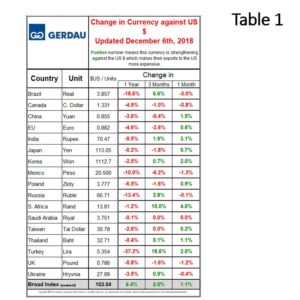Currency Report
The dollar Broad Index posted a reading of 103.0419 for December, up 1.1% month on month. On a twelve moving average, year on year, (y/y) comparison, the Broad Index was up 6.4%.
 Table 1 lists the values of the U.S. dollar measured in the currency of the 17 steel trading nations that we follow as of December 6th. It reports the changes in, one year, 3 months and one month for each currency.
Table 1 lists the values of the U.S. dollar measured in the currency of the 17 steel trading nations that we follow as of December 6th. It reports the changes in, one year, 3 months and one month for each currency.
Over a three month basis, eight countries gained value against the U.S. dollar. Over the last month, the ten countries gained value. The South African Rand, Indian Rupee, and Korean Won strengthened the most against the U.S. Dollar over the last month at 4.0%, 3.1% and 2.0% respectively. Conversely the Brazilian Real, Mexican Peso and British Pound weakened the most against the dollar, declining 3.0%, 1.3% and 1.2%.
Referencing Reuter’s news, China’s foreign exchange reserves unexpectedly rose in November for the first time in four months as the yuan posted a rare gain amid signs of a thaw in trade tensions between Washington and Beijing. The gain in November was due to changes in global currency rates and asset prices, according to China’s State Administration of Foreign Exchange (SAFE), adding it expected reserve levels to remain stable despite market fluctuations.
At Gerdau, we keep a close eye on the currency market because it has a profound impact on both the import and export of raw materials, semi-finished and finished steel. A strengthening USD is a “double-edged sword”, as it makes the U.S. market more attractive other countries to export to the U.S. and conversely imposes strong head-winds for the U.S. to export its products to other nations.

